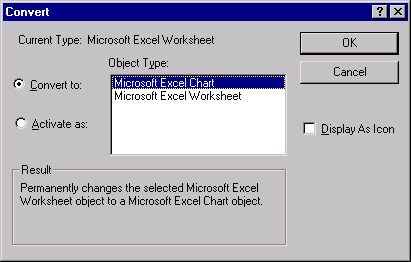Converting OLE Objects
An
OLE object can be associated with only one server application, but
some OLE objects can be converted for use with a different server
application than the one that created them.
You can convert an object
by using the Convert dialog box (shown in Convert Dialog Box). This dialog box lets you:
-
activate the object with a different server application than originally created it, without altering the object type. For example, you can choose to activate a Lotus 1-2-3 object using Microsoft Excel as a server. This action allows you to edit the object as if it were an Excel object. The object continues to be a Lotus 1-2-3 object. All subsequent Lotus 1-2-3 OLE objects you create will use Excel as an OLE server, unless you change the conversion settings again.
